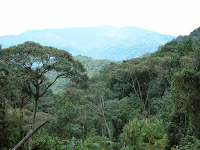 |
| Sabyinyo volcano |
The deciduous forests at the foot of the
Bisoke volcano had a diversity of
mushrooms. But how is it in the bamboo
forests? To answer the question our team will go on an exploratory mission to
three of the volcanoes (Sabyinyo, Gahinga and Karisimbi).
A new local guide accompanied us. His name is Damascene and he knows a lot
about the forest. No wonder as he lived
there for 18 years before leaving, now some twenty years ago.
 First to the Sabyinyo volcano. Many paths wind their way through the
bamboo. They are covered with the
footprints of ungulates. ‘Buffalo’ said Raymond. Judging by the amount of manure there must be
a lot of them.
First to the Sabyinyo volcano. Many paths wind their way through the
bamboo. They are covered with the
footprints of ungulates. ‘Buffalo’ said Raymond. Judging by the amount of manure there must be
a lot of them.
The edible mushrooms are ready for
inspection. Damascene does not know
their names but firmly claims that he has eaten them – also species that
mycologists don’t regard as being edible or very tasty, but probably he did not
have the luxury to be that selective.
 |
What is striking said Jerome are the
mushrooms that grow on bamboos, but their diversity is not so great; maximum a
few Marasmius and Collybia species. In the straw layer of fallen bamboo leaves
almost no mushrooms are to be found there.
Although the diversity of species is not so
great, the bamboos have a few special surprises for us. First surprise: two species of honey
fungus. The true honey fungus (Armillaria mellea) which we know as a pathogen in European forests and its
relation Armillaria heimii.
 |
| Collybia aurea |
Still more surprises were to come: in the
bamboo forests of the Karisimbi volcano our mycologists find the golden collybia
(Collybia aurea), a warm
yellow-coloured species that is considered as a delicacy in the neighbouring
country of Burundi. A little further on
we find Termitomyces robustus, the
famous mushroom that lives in symbiosis with termites. The discovery of this edible species in the
bamboo forests comes as a big surprise.
It’s one for the list of exciting discoveries, we were told by a clearly
satisfied mycologist






















